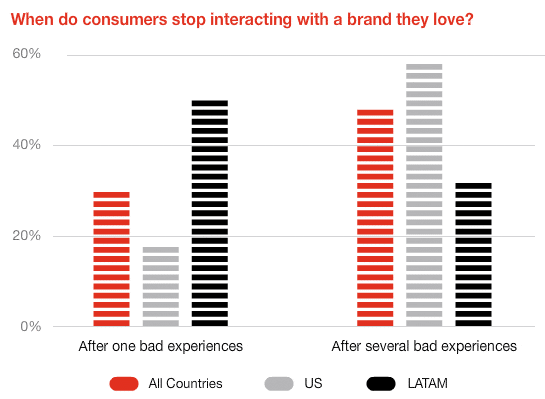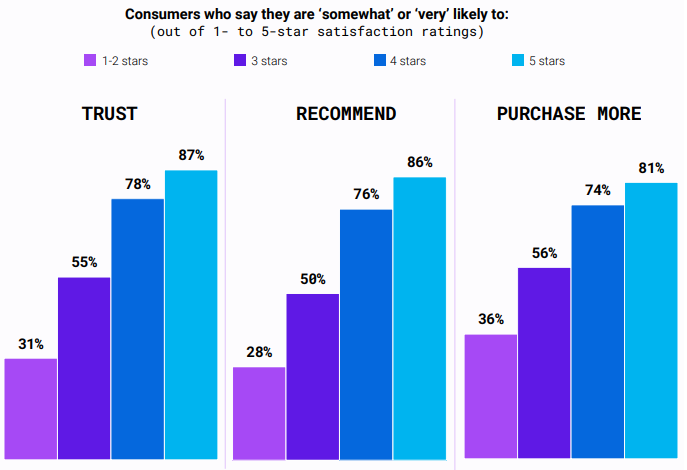Key Features to Elevate Shopify Omnichannel CX

Modern customers demand a seamless omnichannel experience, but basic Shopify setups often lead to fragmented interactions, inconsistent inventory, and fulfillment issues that frustrate shoppers and result in lost sales.
An AI-driven Order Management System (OMS) solves these pain points by providing unified inventory visibility, centralized order tracking, flexible fulfillment options (like advanced BOPIS), and streamlined returns, ultimately enhancing customer satisfaction and driving sales for scaling Shopify retailers.
In today’s retail landscape, customers expect a seamless customer experience across multiple channels, be it online, in-store, mobile app, or on social media. This expectation for a consistent customer experience is not just a preference; it’s a demand. According to Bain & Company, over 50% of customers expect a consistent experience across all channels, whether they’re online or in-store.
However, many businesses fall short of these expectations, resulting in fragmented experiences that frustrate customers and lead to lost sales. In fact, 32% of all customers would stop doing business with a brand they loved after just one bad experience.

Source: PWC
This is where an omnichannel customer experience ensures that customer interactions are integrated and consistent across all touchpoints, providing a seamless customer journey regardless of the channel used.
This article unpacks how AI-driven Order Management Systems (OMS) revolutionize operations, leading to a superior customer experience. We’ll explore some key features that can supercharge your brand’s omnichannel retail strategy, address common pain points in the customer journey, and discuss the ROI of adopting a customer-centric OMS.
Solve common customer experience pain points
A seamless omnichannel customer experience is critical for all modern retailers. For those using platforms like Shopify, ensuring this consistency across touchpoints is key. However, several persistent challenges can hinder this goal. Implementing a robust Order Management System can directly address these pain points, enhancing customer satisfaction and fostering customer loyalty.
Inconsistent inventory information
Discrepancies between online and in-store levels can significantly frustrate customers. When shoppers find a product available online but unavailable in-store, it erodes trust and leads to missed sales opportunities.
In fact, research shows that between 65% and 80% of retail inventory records are inaccurate, often showing either more stock than is actually available or underreporting what’s in-store. That kind of disconnect can turn a routine purchase into a friction-filled experience.
A centralized OMS offers real-time, unified inventory management, ensuring accurate stock information across all channels and preventing such inconsistencies.
Lack of real-time order visibility
These days, customers expect immediate updates on their orders. The absence of real-time order tracking can diminish the customer experience.
An effective OMS provides centralized order visibility, allowing customers to monitor their orders across multiple channels, enhancing transparency and trust.
Inflexible fulfillment options
Modern shoppers value flexibility. Options like Buy Online, Pickup In Store (BOPIS) and ship-from-store have become standard expectations now.
While Shopify does offer BOPIS capabilities, there are certain limitations in its native functionalities. A robust OMS can extend and enhance these features, offering more flexible fulfillment options that cater to diverse customer preferences.
Difficult returns and exchanges
A cumbersome return process can deter repeat business. Disjointed systems make returns and exchanges a hassle, negatively impacting customer retention.
An integrated OMS streamlines the returns process across all touchpoints, making it more convenient for customers and reinforcing a positive omnichannel experience.
Lack of personalized experiences
Personalization is no longer a luxury; it’s a necessity. Failing to tailor interactions based on cross-channel behavior results in missed opportunities to engage customers effectively.
An OMS enables you to deliver a personalized experience that resonates with individual customer needs by leveraging customer data collected across various channels.
Key features that supercharge Shopify omnichannel CX
As a Shopify merchant, you can leverage specific Order Management System features to meet evolving customer expectations and deliver a seamless customer experience across multiple channels.
These capabilities not only enhance operational efficiency but also significantly improve customer satisfaction and customer loyalty.
Unified inventory management
Accurate, up-to-the-second inventory data across all Shopify-connected channels prevents overselling and ensures product availability, leading to fewer disappointed customers. Implementing real-time inventory management allows you to maintain optimal stock levels, reducing stockouts and overstock situations.
This transparency ensures that customers interact with reliable information, enhancing trust and encouraging repeat business.
Centralized order visibility
An OMS provides a single view of every order, regardless of origin or fulfillment method, enabling better customer service and proactive communication about order status.
This centralized approach allows customer support agents to access comprehensive order histories, facilitating quicker resolution and personalized assistance. As a result, the entire customer journey becomes more cohesive and satisfying.
Flexible fulfillment options
While Shopify offers Buy Online, Pickup In Store (BOPIS) capabilities, certain limitations exist. A robust OMS can extend and enhance these features, offering more flexible fulfillment options that cater to diverse customer preferences.
By integrating options like ship-from-store, you can provide faster delivery times and convenient pickup locations, aligning with the preferred channels of your omnichannel customers.
Intelligent order routing
An OMS can automatically route orders to the optimal fulfillment location (store, warehouse) based on proximity, availability, and cost, leading to faster delivery and potentially lower shipping fees for your customers.
This intelligent routing ensures that orders are fulfilled efficiently, reducing delivery times and enhancing the customer experience. While Shopify has some baseline capabilities in this aspect, an advanced OMS can offer more sophisticated routing options that adapt to real-time conditions and customer behavior.
Streamlined returns and exchanges
A centralized OMS simplifies the returns process across all channels, making it easier and less frustrating for your customers. By providing clear return policies and easy-to-use return portals, you can address customer concerns promptly, reducing friction and fostering customer loyalty.
This streamlined approach ensures that customer interactions during returns are as positive as the initial purchase experience.
Personalized experiences through data
An OMS can collect and analyze cross-channel order and customer data, enabling Shopify stores to personalize product recommendations, promotions, and customer service interactions. By understanding customer behavior and customer preferences, you can create detailed customer personas and tailor your offerings accordingly.
This level of personalization enhances customer engagement and supports a successful omnichannel platform strategy that strengthens relationships with both new and existing customers.
By integrating these OMS features, you can deliver a consistent brand experience across multiple platforms, addressing key pain points and elevating the omnichannel customer experience. Comprehensive solutions, such as fabric, can complement the capabilities of your Shopify account, offering advanced tools to meet the demands of modern retail and drive customer retention and growth.
Implementing OMS features for a customer-first approach
To deliver a superior omnichannel customer experience, as a Shopify store owner, you must strategically implement OMS features with a focus on the customer journey.
1. Map the customer journey
Begin by conducting a customer journey map to visualize the entire shopping experience, from discovery to post-purchase. This process helps identify critical moments where customer interactions occur, allowing you to pinpoint areas where OMS features can enhance the experience.
By understanding the entire customer journey, you can tailor your strategies to address specific pain points and improve customer satisfaction, and deliver consistent omnichannel customer service across all touchpoints.
An AI-based research shows that 87% of retailers report customer journey mapping increases sales and marketing ROI. That’s because visualizing how customers interact across multiple touchpoints can help you align OMS features with real-life customer needs.
2. Identify key moments for integration
Once the journey is mapped, identify stages where OMS features can have the most significant impact:
- Inventory visibility: Ensure real-time inventory management to prevent stock discrepancies that frustrate customers.
- Order tracking: Offer centralized order visibility, allowing customers to track their purchases with ease.
- Flexible fulfillment: Offer options like BOPIS and ship-from-store to cater to customer preferences for delivery.
- Personalization: Utilize customer data to personalize recommendations and communications, enhancing customer engagement.
- Feedback: Collect customer feedback at key stages to fine-tune your services and respond to shifting customer needs.
3. Choose the right OMS integrations
Selecting an OMS that complements your Shopify account is very crucial. Look for solutions that:
- Integrate smoothly with Shopify’s platform.
- Support an omnichannel marketing strategy by unifying data across digital and offline channels.
- Provide tools for customer journey mapping and analytics to track key performance indicators (KPIs).
- Enhance customer support agent efficiency by consolidating order and inventory information, an essential step in delivering consistent omnichannel customer service across all touchpoints.
The ROI of a customer-centric OMS for Shopify growth
Investing in a customer-centric OMS is not just about operational efficiency; it’s a strategic move that can significantly enhance your Shopify store’s profitability and customer relationships. By focusing on the omnichannel customer experience, you can unlock tangible benefits that drive growth and sustainability.
Enhanced customer satisfaction and loyalty
Delivering a seamless customer experience across multiple channels ensures that customers consistently interact with your brand. This consistency builds trust and fosters customer loyalty.
According to a study by the XM Institute, consumers who rate an experience as 5-star are:
- 2.9 times more likely to trust the company,
- 3.0 times more likely to recommend the company,
- 2.2 times more likely to purchase more from the company.

Source: Qualtrics
This highlights the importance of investing in systems that enhance the customer journey and meet customer expectations.
Increased customer LTV and reduced churn
A robust OMS enables you to track customer interactions and analyze customer behavior, allowing for personalized experiences that resonate with customer preferences. This personalization leads to increased customer retention and higher lifetime value. Moreover, satisfied customers are less likely to switch to competitors, reducing customer churn and helping to boost sales through ongoing brand loyalty and referrals.
Operational efficiency and cost savings
Implementing an OMS streamlines processes like inventory management, order fulfillment, and returns. This efficiency reduces errors, saves time, and lowers operational costs. Additionally, by offering self-service options and integrating various communication channels, you can better cater to customer needs.
Empower seamless customer experiences
Creating a unified omnichannel customer experience is a necessity in today’s competitive retail landscape. As Shopify merchants navigate the complexities of selling across multiple channels, from their mobile site to the physical store, a customer-first OMS is the perfect solution.
As a Shopify merchant, investing in enhancing your omnichannel retail strategy through smart OMS implementations will better position you to meet evolving customer needs, exceed customer expectations, and adapt to future retail trends.
Contact us and take your Shopify store’s customer experience to the next level by exploring our advanced OMS solutions.

Digital content editorial team @ fabric






